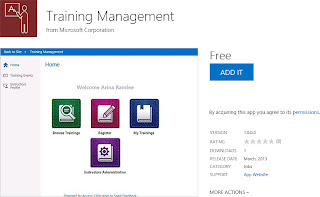You can use the navigation on the left to filter the displayed apps, or you can use the search box in the top right corner. For example, I searched on “Access” to see all of the Access apps currently available.
Since I was a corporate trainer for 11 years, I’m especially interested in the Training Management app. If you hover over an app, you’ll see its description. To purchase the app (even if it’s free), start by clicking on the app.
Once you click on the button to Add It, you’ll be prompted to confirm that you wish to add the app. Simply press the Continue button.
Now that you have acquired an app from the SharePoint store, you need to install the app on one or more of your SharePoint sites. First, navigate to the site where you want to add the app. From the getting started section of your site, click Add lists, libraries, and other apps.
In the section titled Apps you can add, you’ll see the app you just acquired. (You can also sort the apps by Name or page through the apps until you find the one you want to add.) To begin the app installation process, click on the app. You will be asked if you trust the app. Click Trust It to continue.
SharePoint then takes you to the Site Contents page, where you can see all of your lists, libraries, and apps. Locate your new app and click on it to open it. Just like with our custom web apps built from scratch and from a template, the Access app has a list view form and a datasheet view form for each table. You can add, edit, and delete data within the tables. However, depending on the app’s author, you may or may not be able to edit the tables in Access. For the Training Management Access app, there is no option to edit the tables. From a support perspective, that makes sense.
This post concludes my blog
series on Access apps in SharePoint 2013. But wait – there’s more! Even though
I promised you three parts, we haven’t looked at creating a table from an
existing data source, such as an Excel file or a SharePoint list. Because this
is a valuable option, I’ll do a bonus round to this blog series. Stay tuned!














